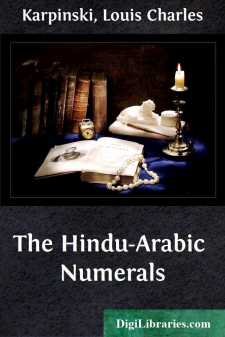Categories
- Antiques & Collectibles 13
- Architecture 36
- Art 48
- Bibles 22
- Biography & Autobiography 813
- Body, Mind & Spirit 141
- Business & Economics 28
- Children's Books 12
- Children's Fiction 9
- Computers 4
- Cooking 94
- Crafts & Hobbies 4
- Drama 346
- Education 46
- Family & Relationships 57
- Fiction 11826
- Games 19
- Gardening 17
- Health & Fitness 34
- History 1377
- House & Home 1
- Humor 147
- Juvenile Fiction 1873
- Juvenile Nonfiction 202
- Language Arts & Disciplines 88
- Law 16
- Literary Collections 686
- Literary Criticism 179
- Mathematics 13
- Medical 41
- Music 40
- Nature 179
- Non-Classifiable 1768
- Performing Arts 7
- Periodicals 1453
- Philosophy 64
- Photography 2
- Poetry 896
- Political Science 203
- Psychology 42
- Reference 154
- Religion 513
- Science 126
- Self-Help 83
- Social Science 81
- Sports & Recreation 34
- Study Aids 3
- Technology & Engineering 59
- Transportation 23
- Travel 463
- True Crime 29
The Hindu-Arabic Numerals
Categories:
Description:
Excerpt
CHAPTER I
EARLY IDEAS OF THEIR ORIGIN
It has long been recognized that the common numerals used in daily life are of comparatively recent origin. The number of systems of notation employed before the Christian era was about the same as the number of written languages, and in some cases a single language had several systems. The Egyptians, for example, had three systems of writing, with a numerical notation for each; the Greeks had two well-defined sets of numerals, and the Roman symbols for number changed more or less from century to century. Even to-day the number of methods of expressing numerical concepts is much greater than one would believe before making a study of the subject, for the idea that our common numerals are universal is far from being correct. It will be well, then, to think of the numerals that we still commonly call Arabic, as only one of many systems in use just before the Christian era. As it then existed the system was no better than many others, it was of late origin, it contained no zero, it was cumbersome and little used, and it had no particular promise. Not until centuries later did the system have any standing in the world of business and science; and had the place value which now characterizes it, and which requires a zero, been worked out in Greece, we might have been using Greek numerals to-day instead of the ones with which we are familiar.
Of the first number forms that the world used this is not the place to speak. Many of them are interesting, but none had much scientific value. In Europe the invention of notation was generally assigned to the eastern shores of the Mediterranean until the critical period of about a century ago,—sometimes to the Hebrews, sometimes to the Egyptians, but more often to the early trading Phœnicians.
The idea that our common numerals are Arabic in origin is not an old one. The mediæval and Renaissance writers generally recognized them as Indian, and many of them expressly stated that they were of Hindu origin. Others argued that they were probably invented by the Chaldeans or the Jews because they increased in value from right to left, an argument that would apply quite as well to the Roman and Greek systems, or to any other. It was, indeed, to the general idea of notation that many of these writers referred, as is evident from the words of England's earliest arithmetical textbook-maker, Robert Recorde (c. 1542): "In that thinge all men do agree, that the Chaldays, whiche fyrste inuented thys arte, did set these figures as thei set all their letters. for they wryte backwarde as you tearme it, and so doo they reade. And that may appeare in all Hebrewe, Chaldaye and Arabike bookes ... where as the Greekes, Latines, and all nations of Europe, do wryte and reade from the lefte hand towarde the ryghte." Others, and among them such influential writers as Tartaglia in Italy and Köbel in Germany, asserted the Arabic origin of the numerals, while still others left the matter undecided or simply dismissed them as "barbaric." Of course the Arabs themselves never laid claim to the invention, always recognizing their indebtedness to the Hindus both for the numeral forms and for the distinguishing feature of place value....


